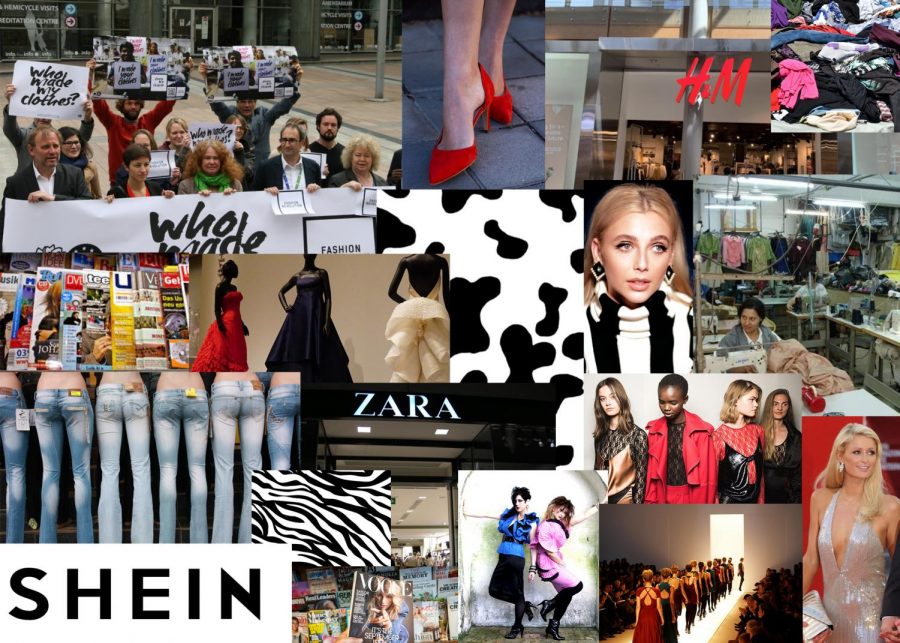Fast Fashion
The Dictator of The Fashion Industry
October 29, 2021
Culture & Trends
Clothing is now considered disposable after just a few wears. “I think fast fashion is centered around impulse. One loves a piece for a little bit and then it’s completely useless. It’s kind of like a ‘live fast, die young’ situation,” Tyler Hack, the co-chair of Effect, Masters’ sustainability club said.
Social media and the internet, particularly Instagram and TikTok, fuel the problem. These applications platform new trends everyday, many of which only last a couple weeks. Influencers are constantly keeping people up to date by posting new trends on their social media feeds.“A lot of social media influencers encourage the idea of never repeating an outfit,” said Aimee Aya-la, co-chair of Upcycle, Masters sustainable fashion club. Until the mid-twentieth century, the fashion industry had four seasons – fall, winter, spring and summer. Fashion designers would work for months to plan for each season based on predictions of the styles they thought customers would desire. Today, the fashion industry is producing about 50 “micro-seasons’’ per year.“Clothing has really evolved over time. Fast fashion has given a lot of people the means to be able to wear whatever they want, whenever they want, at a really good price,” Meskin said. Approximately 1.7 billion people worldwide now belong to the consumer class, which is composed of people who buy items that are not essential and are not part of their basic needs.“A closet nowadays is not about hav-ing nice pieces that are special to you. It is more about quantity than quality,” said Meskin. According to Insider, consumers bought 60 percent more garments in 2014 than in 2000.“Instead of clothing being a form of expression where you express your unique and personal style through the clothes you buy, it just becomes an idea of who looks best…It feels very competitive,” said Ayala.
Human Rights
In the Spring of 2021, Masters Effect organized a thrift store, encouraging sustainable practices and the reuse of clothes. This stands in contrast with the fast fashion companies which quickly create knock-offs of more expensive items from high-end brands.“That creates a competitiveness within the market of those companies and within young people themselves. You then have the competitiveness of kids from low-income areas who don’t have the money to buy from brands like I.AM.GIA, House of Sunny or Revolve, versus those who are buying Shein just so they can keep up with trends,” said Ayala. In recent years, the online clothing brand, Shein, has grown increasingly popular. According to Euromonitor International, it’s now the largest online-only fashion company in the world. The brand is notorious for its fast turn around from factory to consumer. On average 3,000 new styles are added its website weekly. On applications such as Tik Tok, consumers post Shein hauls, totalling to many hundreds of dollars, supporting Shein and furthering consumption of unethical brands. Consumers have a choice to spend their money on fast fashion, which does not last or purchase fewer items from sustainable brands which are of higher quality and will last. A 2017 report from the International Union for Conservation of Nature (IUCN) estimated that 35 percent of all micro-plastics in the ocean came from the laundering of synthetic textiles like polyester. “Trend cycles and fast fashion are incredibly wasteful. Things go out of style so quickly. It causes an endless cycle of buying and throwing away clothing,” said Ayala. The fashion industry alone accounts for about 10 percent of global carbon emissions, and about 20 percent of wastewater. In 2015, 79 billion tons of water were used by the fashion industry. Upwards of 10,000 liters of water are required to grow about 2.2 pounds of cotton, a plant typically produced in regions heavily affected by droughts. On average it takes about 660-713 gallons of water to make one t-shirt and over 10,000 liters of water to make a single pair of jeans. This process pro-duces an estimated 33.4 kg of carbon,“When the high-end fashion industry turns over a trend into dupes, the quality of the garment goes down, and with it, so do labor standards,” said Hack.
Environment
What’s more, labor rights are negatively affected by fast fashion in many ways, which, in turn, hurts both consumers and factory workers. Harmful chemicals such as benzothiazole that are linked to cancer and respiratory illnesses have been found in fast fashion clothing that is manufactured. In addition to toxicity, fast fashion relies on international labour. The industry has turned to low-income countries like Bangladesh, India, China, Vietnam, and the Philippines to exploit workers and produce clothing at a cheap rate. An Oxfam 2019 report found that no Bangladeshi garment workers, and only 1 percent of Vietnamese garment workers, earned a living wage. Garment workers, typically women and children, are forced to work strenuous hours with unfair wages. They also suffer abuse in the workplace. The fast fashion industry is not only harmful to the environment. It also violates basic human rights. Meskin offered several ways members of the Masters community could find alternatives to buying into this consumer phenomenon.“Masters students can help address these problems by shopping cautiously. They can emphasize thrifting, using Depop,












